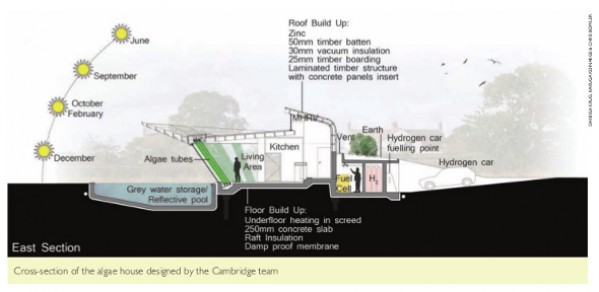
A design for a house powered by living algae, drawn up by students at the University of Cambridge, has won a prestigious international competition.
Algae and people may not present themselves as obvious bedfellows, but through this project we hope to show that the integration of algae as an energy generator within a house is not only feasible, but that it opens up many exciting architectural possibilities for green living.
Karuga Koinange, Department of Architecture
The student team included two students from Engineering; Ben Sheppard and Oliver Hudson along with students from the Department of Architecture; Karuga Koinange, Chris Bowler, David Valinsky and Daniela Krug.
The project is part of the Architectural Engineering module, a joint course wherein final year and graduate engineers and architects work together in multidisciplinary teams to develop innovative, sustainable, low-energy designs for buildings. The module is taught by Allan McRobie from Engineering and Michael Ramage from Architecture.
The "Algae House", which it is believed could provide a model for future energy-efficient living, would use the hydrogen and bio-mass created by the cultivation of algae as a renewable source.
The house design was awarded first prize in an international design competition run by the 3rd CIB International Conference on Smart and Sustainable Built Environments. A great result from multidisciplinary work.
The competition challenged students to propose a concept of a small home that produces enough sustainable energy to equal out energy consumption.
The winning team, called "Algaetecture", created the blueprint for a house using in-built algae tubes, photo bio-reactor, to generate hydrogen. A glazing system and water pool are incorporated into the design to mitigate - reflect and cool - the sunlight the algae need to thrive. It is estimated that the house would produce 4,100 KW/h of hydrogen and bio-mass per year - enough to drive an electric MINI E car from London to Beijing and back twice over .
"Algae and people may not present themselves as obvious bedfellows, but through this project we hope to show that the integration of algae as an energy generator within a house is not only feasible, but that it opens up many exciting architectural possibilities for green living," Karuga Koinange, from the Department of Architecture, said.
The competition, held at Delft University of Technology in the Netherlands, was organised and sponsored by the International Council for Research and Innovation in Building and Construction (CIB), the Passive and Low Energy Architecture association (PLEA) and the International Initiative for a Sustainable Built Environment (iiSBE). The students presented their work throughout the week long proceedings to a variety of conference attendees, including the Dutch Crown Prince, Willem Alexander whom highly commended the concept.

